
Viterbo is a city and comune (municipality) in the Lazio region of Italy, the capital of the province of Viterbo.

The province of Benevento is a province in the Campania region of Italy. Its capital is the city of Benevento.

Todi is a town and comune (municipality) of the province of Perugia in central Italy. It is perched on a tall two-crested hill overlooking the east bank of the river Tiber, commanding distant views in every direction. It was founded in antiquity by the Umbri, at the border with Etruria; the gens Ulpia of Roman emperor Trajan came from Todi.

Gubbio is an Italian town and comune in the far northeastern part of the Italian province of Perugia (Umbria). It is located on the lowest slope of Mt. Ingino, a small mountain of the Apennines.

The Palazzo Vecchio is the town hall of Florence, Italy. It overlooks the Piazza della Signoria, which holds a copy of Michelangelo's David statue, and the gallery of statues in the adjacent Loggia dei Lanzi.

Cagli is a town and comune in the province of Pesaro e Urbino, Marche, central Italy. It is c. 30 kilometres south of Urbino. The Burano flows near the town.

Giuliano da Maiano (1432–1490) was an Italian architect, intarsia-worker, and sculptor, the elder brother of Benedetto da Maiano, with whom he often collaborated.
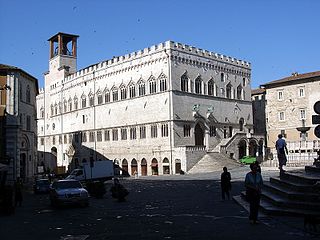
The Palazzo dei Priori or comunale is one of the best examples in Italy of a public palace from the communal era. It is located in the central Piazza IV Novembre in Perugia, Umbria. It extends along Corso Vannucci up to Via Boncambi. It still houses part of the municipality, and, on the third floor, the Galleria Nazionale dell'Umbria. It takes its name from the Priori, the highest political authority governing the city in the medieval era.

Palazzo Antinori is a Renaissance palace located at the north end of Via de' Tornabuoni, where it makes an odd corner with Via dei Pecori, Via del Trebbio, and converts into Via dei Rondinelli, in Florence, Italy.
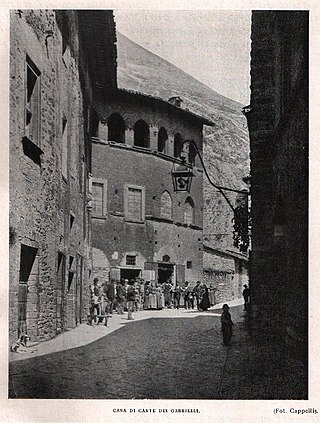
The Palazzo del Capitano del Popolo or Palazzo di Cante Gabrielli is a medieval palace in Gubbio, Italy. It is located in the San Martino's quartiere, near Porta Metauro, at the corner of via Gabrielli and via Capitano del Popolo.

The Palazzo dei Consoli is a Gothic architecture, civic building in the historic center of Gubbio, region of Umbria, Italy. Construction took place during 1332–1349 under design by Angelo da Orvieto; the palace was built on a large platform built against the hillside and looming over the town below.

Piazza d'Aracoeli is a square of Rome (Italy), placed at the base of the Capitoline Hill, in the Rione X Campitelli.
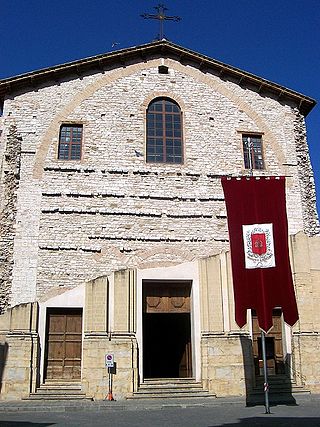
The church of San Domenico, also sometimes called San Martino, is a medieval Roman Catholic church in the lower town of Gubbio, Umbria, in Italy. At one time, the church was dedicated to St Martin of Tours.
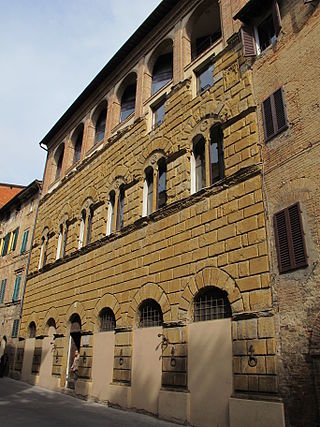
The Palazzo San Galgano is a Renaissance style urban palace located on via Roma number 47, in Terzo Camollia of the city of Siena, region of Tuscany, Italy. The palace is around the corner from the church of San Raimondo.

Gualdo Tadino Cathedral is a Roman Catholic cathedral in Gualdo Tadino in Umbria, Italy, dedicated to Saint Benedict of Nursia. Formerly a Benedictine abbey church, it became a cathedral in 1915, and is now a co-cathedral in the diocese of Assisi-Nocera Umbra-Gualdo Tadino.
The Madonna Del Porto, also known as the Madonna della Scala, is a Neoclassic-style, Roman Catholic church located in Pesaro, region of Marche, Italy.

San Francesco is a Gothic-style, Roman Catholic, Franciscan church in Cagli, province of Pesaro e Urbino, region of Marche, Italy.

Borgo Nuovo, originally known as via Alessandrina, also named via Recta or via Pontificum, was a road in the city of Rome, Italy, important for historical and architectural reasons. Built by Pope Alexander VI Borgia for the holy year of 1500, the road became one of the main centers of the high Renaissance in Rome. Borgo Nuovo was demolished together with the surrounding quarter in 1936–37 due to the construction of Via della Conciliazione.
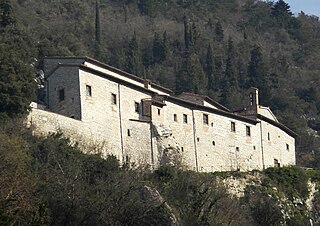
The Monastero or Eremo di Sant'Ambrogio is a 14th-century Roman Catholic church and monastery located on Via Guido Bonarelli #5 nestled on high slopes of Monte Foce, north of Gubbio, region of Umbria, in Italy. It was initially founded as a rustic Franciscan hermitage following Augustinian rules, outside the city walls of Gubbio.

San Pietro is an ancient Roman Catholic church and former monastery located on piazza San Pietro in central Gubbio, region of Umbria, in Italy. The church which displays architectural elements from many centuries, from Romanesque to the Renaissance, as well as housing prominent artworks; the monastery now houses the civic Biblioteca Comunale Sperelliana.



















